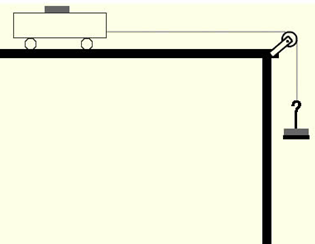Reference no: EM13897956
Physics Lab - Newton's Second Law
The purpose of this experiment is to validate Newton's Second Law of Motion. In part A the lab cart will be accelerated by various net forces while keeping mass constant. In part B the lab cart will be accelerated by a constant net force while its mass is varied. The goal is to determine the relation between acceleration and force and the relation between acceleration and mass. The force on the lab cart is controlled and provided by gravity acting on a weight at the end of a string that passes over a pulley at the end of a lab table.

Instructions:
• Go to https://www.walter-fendt.de/ph14e/n2law.htm
• Keep the default setting for s (0.500 m) and µ (0.000)
Part A
• Set M = 99 g and m = 1 g
• Click the START button.
• Record the acceleration value.
• Click the reset button.
• Repeat the experiment and fill the table below. Force data is collected by calculating the weight of the calibrated masses added to the end of the string. (g= 9.81 m/s²)
|
M (g)
|
m (g)
|
a (m/s²)
|
F=mg (N)
|
|
99.0
|
1.0
|
.098
|
|
|
98.0
|
2.0
|
.196
|
|
|
97.0
|
3.0
|
.294
|
|
|
96.0
|
4.0
|
.392
|
|
|
95.0
|
5.0
|
.491
|
|
|
94.0
|
6.0
|
.589
|
|
|
93.0
|
7.0
|
.687
|
|
|
92.0
|
8.0
|
.785
|
|
|
91.0
|
9.0
|
.883
|
|
|
90.0
|
10.0
|
.981
|
|
In this part of the experimentmass is removed from the cart and placed on the end of a string passing over a pulley. By doing this the amount of net force will be varied while keeping constant the total amount of mass (100 g) being accelerated. It is important to note that the pull of gravity on the dangling mass causes not only the cart and its contents to accelerate, but also the string itself and the mass or masses attached to the end of the string. Put another way, the weight on the end of the string causes all of the mass to accelerate (and it all accelerates at the same rate).
Use these results to construct a force vs. acceleration graph. For this graph,plot the independent variable (force) on the y-axis.Determine the best fit.How does the shape of this graph look? What does this imply about the relationship between force and acceleration when the mass is constant?
Part B
• Set M = 100 g and m = 10 g
• Click the START button.
• Record the acceleration value.
• Click the reset button.
• Repeat the experiment and fill the table below.
|
M (g)
|
m (g)
|
a (m/s²)
|
M + m (g)
|
F=mg (N)
|
|
100.0
|
10.0
|
.892
|
|
|
|
110.0
|
10.0
|
.818
|
|
|
|
120.0
|
10.0
|
.755
|
|
|
|
130.0
|
10.0
|
.701
|
|
|
|
140.0
|
10.0
|
.654
|
|
|
|
150.0
|
10.0
|
.613
|
|
|
|
160.0
|
10.0
|
.577
|
|
|
|
170.0
|
10.0
|
.545
|
|
|
|
180.0
|
10.0
|
.516
|
|
|
|
190.0
|
10.0
|
.491
|
|
|
Use these results to construct an acceleration vs. 1/total mass graph. On this graph the x-variable is the reciprocal of the total mass being accelerated. How does the shape of this graph look? What does this imply about the relationship between acceleration and mass when the force is constant?
|
Calculate the critical current for a tin wire
: The superconductor tin has Tc = 3.7 K and Bc = 30.6 mT at T = 0. Calculate the critical current for a tin wire of diameter 1 mm at T = 2K. What diameter of wire would be required to carry a current of 100A
|
|
Calculate the concentration of nacl
: Determine the [NaCl] in ppm in the original diluted 100 mL flask.
|
|
Calculate the electrostatic energy for this interaction
: There is always some uncertainty in the value of the dielectric constant, too. Using the charge values in problem 3, calculate the energy if we had used a dielectric constant of 2. once again, is the error large enough that we should be concerned,..
|
|
Calculate the freezing point f the solution
: Calculate the freezing point f the solution. (The density of the solution is 1.037 g/mL. MWt of glucose = 180 g/mole)A) 1.07 C B) 296.9 K C) -1.00 C D) +1.00 C E) 272.08K
|
|
Relationship between acceleration and mass
: On this graph the x-variable is the reciprocal of the total mass being accelerated. How does the shape of this graph look? What does this imply about the relationship between acceleration and mass when the force is constant
|
|
What would be the de broglie wavelength
: What would be the de Broglie wavelength of a helium atom (atomic weight = 4.00 g/mol) moving at 100 m/s ?
|
|
What is chromatography
: How do differences in polarity and molecular weight between amino acids affect migration in a mixture of proteins?
|
|
What mass of potassium fluoride
: The answer is E. I'm confused doing the step by step procedure. I'm not sure why we use [H+]=10^-pH and Ka*Kb=Kw. What mass of potassium fluoride must be added to 500.0 mL of water to give a solution with pH = 8.07? [Ka(HF) = 7.1 × 10-4]
|
|
How are spectrophotometric measurements used
: What are the advantages and disadvantages in using spectrophotometric measurements for the analysis of various compounds?
|